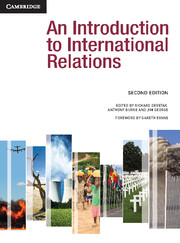Book contents
- Frontmatter
- Contents
- Tables, Figures and Boxes
- Contributors
- Preface and acknowledgements
- An Introduction to International Relations: The origins and changing agendas of a discipline
- 1 Theories of International Relations
- 2 The Traditional Agenda
- 3 The New Agenda
- 21 The United Nations
- 22 Non-State Actors: Multinational Corporations and International Non-Governmental Organisations
- 23 Religion and Secularism
- 24 Global Economic Institutions
- 25 Global Trade
- 26 Global Finance
- 27 Global Poverty, Inequality and Development
- 28 Globalisation and Its Critics
- 29 Global Terrorism
- 30 Post-Conflict State-Building
- 31 Humanitarian Intervention
- 32 Human Rights
- 33 Migration and Refugees
- 34 Global Environmental Politics
- 35 Climate Change
- Glossary of Terms
- Bibliography
- Index
- References
25 - Global Trade
from 3 - The New Agenda
- Frontmatter
- Contents
- Tables, Figures and Boxes
- Contributors
- Preface and acknowledgements
- An Introduction to International Relations: The origins and changing agendas of a discipline
- 1 Theories of International Relations
- 2 The Traditional Agenda
- 3 The New Agenda
- 21 The United Nations
- 22 Non-State Actors: Multinational Corporations and International Non-Governmental Organisations
- 23 Religion and Secularism
- 24 Global Economic Institutions
- 25 Global Trade
- 26 Global Finance
- 27 Global Poverty, Inequality and Development
- 28 Globalisation and Its Critics
- 29 Global Terrorism
- 30 Post-Conflict State-Building
- 31 Humanitarian Intervention
- 32 Human Rights
- 33 Migration and Refugees
- 34 Global Environmental Politics
- 35 Climate Change
- Glossary of Terms
- Bibliography
- Index
- References
Summary
Introduction
This chapter examines both the concepts and the structures of the global trading regime before considering the ensuing debates. First, it explains the international free trade regime and the opportunities it affords. Second, it identifies some of the problems that have beset this system. Third, it notes the growth in preferential trade agreements. Fourth, it considers the prospects for reform of the global trading system; and fifth, it examines the impact of the Global Financial Crisis on global trade, before examining the prospects for recovery. Key terms relating to global trade are explained in Box 25.1.
The global trade regime has been variously praised as providing the engine for global growth and critiqued for exploiting weaker players in the international system. The intense protests at the World Trade Organization (WTO) Millennium Round’s Third Ministerial Meeting in Seattle in November and December 1999 were a dramatic illustration of the disputes being fought over the operation of the world trading regime. These public battles reflected both intellectual and policy concerns surrounding the nature of global trade. In particular, this major dispute reveals a broad coalescence of dissatisfaction with the liberal international economic order that was established immediately after World War II. Born after a period of devastation wrought through two world wars and the Great Depression, the new economic order attempted to remove barriers to trade, promote prosperity and thereby prevent a repeat of past tragedies. The emergent system sponsored by the US aimed to implement a liberal trading regime that both espoused and practised free and open trade. Part of the post-war reconstruction process involved countries profiting from access to markets and removal of barriers to capital movement. Towards the latter half of the twentieth century this process was given greater impetus through rapid developments in transportation and communication. Market internationalisation increased significantly and countries became increasingly interdependent. In short, international trade and prosperity expanded enormously during this period.
- Type
- Chapter
- Information
- An Introduction to International Relations , pp. 348 - 359Publisher: Cambridge University PressPrint publication year: 2011

